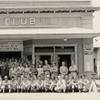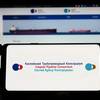Innovators Recognized at Patent Ceremony
Combined Wedge-Flap for Improved Ship Powering
United States Patent No. 6,038,995, Cusanelli, D.S., and G. Karafiath, (March 21, 2000)
A stern flap is an extension of the hull bottom surface which extends aft of the transom. It is a relatively small appendage, built of plate, fitted to the ship's transom. Unlike a stern flap that extends aft of the transom, wedges are located completely under the hull beneath the transom (inlayed into the hull plating). The critical geometry parameters for both wedges and flaps are chord length, span across the transom, and angle. Transom wedges and stern flaps are very similar, and also operate along similar principles, and as thus, were previously viewed as exclusive devices.
A wedge-flap design program was initiated in 1996, when it was rationalized that the combination of a wedge and a lap might prove beneficial. This program represented the initial model-scale evaluation of a wedge and flap combination.
The combination of the two concepts, named the integrated wedge-flap, initiates forward of the transom under the hull (wedge portion) and extends aft of the transom (flap portion). It was shown, through model testing, that a stern flap, installed in addition to a hull's existing wedge, could further reduce the powering requirements. U.S. patent No. 6,038,995 was issued to Cusanelli and Karafiath for this design concept.
The stern flap portion (alone) of the integrated wedge-flap, was retrofit to the Ramage (DDG 61), in 2000. This ship is an Arleigh Burke (DDG 51) Class, Flight I, destroyer, which was built with an inlayed stern wedge. A photograph of the Ramage installation was not available, however, the equivalent design on a sister ship, the Curtis Wilbur (DDG 54.
The stern flap trials on Ramage were recently completed in December 2000. The results indicate that the flap, for all speeds tested, substantially reduced delivered power by 5-15 percent, while top speed was increased by 0.9 knots. Projected net annual fuel savings will be over 4,700 barrels (7.5 percent reduction), with a total fuel cost savings of $195,000 per ship. Fabrication and installation cost was $160,000, indicating that the period for return of investment cost will be less than one year.
Foil Assisted Towing System
An improvement in delivering cargo could revolutionize littoral warfare and generate cost savings for the Navy. The new concept borrows ideas from trucks and hydrofoils.
Foil Assisted Towing System (FATS) permits the close coupled towing of craft or other payloads using partial hydrofoil support. Conceptionally, the towing method is analogous to a highway tractor-trailer rig, which is supported on the front by the transom of the towing craft. A hydrofoil supports the aft end of the trailer. This concept has the advantages of hydrofoils while avoiding their faults-motion control, stability, propulsion, spray, complexity, etc. The program's goal: building a scale model FATS and successfully demonstrating it in a real, operational environment. Combatant Craft Department (CCD) personnel who worked on the project were: John Almeter, Jason Marshall and Dennis Bushey (all of Code 23). Additionally, they have applied for a patent.
A FATS could be used for towing small equipment and cargo. The towed item is semi-rigidly attached to the towing craft at the stern in manner similar to that of a tractor-trailer rig. The transom of the towing craft supports a small percentage of the weight of the towed craft. When being towed at high speed, a hydrofoil supports the majority of the towed weight. At slower speeds, hydrostatic forces support the towed craft. Large high-speed craft can use this concept to tow boats, equipment, cargo and fuel bladders. However, using this approach it is questionable whether it would ever be practical to tow thousands of tons of cargo. Specific requirements would determine applicability.
Since it can have extremely low resistance when on foil, the hydrofoil is an attractive option. The low resistance translates to smaller horsepower requirements and fuel consumption. Various problems have prevented the hydrofoils from being widely used. For example, control and stability are major problems. Propelling a hydrofoil can be extremely difficult. Struts can generate a large amount of spray, which strike the craft, increasing its drag. In practice, the hydrofoil's simple concept presents a challenge in actual working environments. Problems are often avoided by using a hybrid hydrofoil craft, which is part hydrofoil and part some other type of craft. Examples include Techno-Superliner, Super Shuttle 400 and Foilcat 2900. Hybrid Hydrofoils have been in operation in Russia for decades. Their Turya and Matka class of craft - with a 250 ton displacement - is a mix of semi-planing hull and a hydrofoil. The bottom of the craft itself supports the aft end of the craft; a hydrofoil supports the forward end. Providing stability and control, this approach allows a conventional inboard propeller propulsion.
Some could argue that the FATS is a hybrid hydrofoil system. The bottom of the towed craft supports the forward end. A hydrofoil supports the back end. However, FATS is different because hydrofoils have not been towed before by a conventional monohull. This application is unique because previous hybrid hydrofoils were in one craft, not the tractor-trailer rig like arrangement of FATS. The connection to the towed craft provides stability and control. Because of the towing, complex propulsion systems associated with true hydrofoils are avoided.












